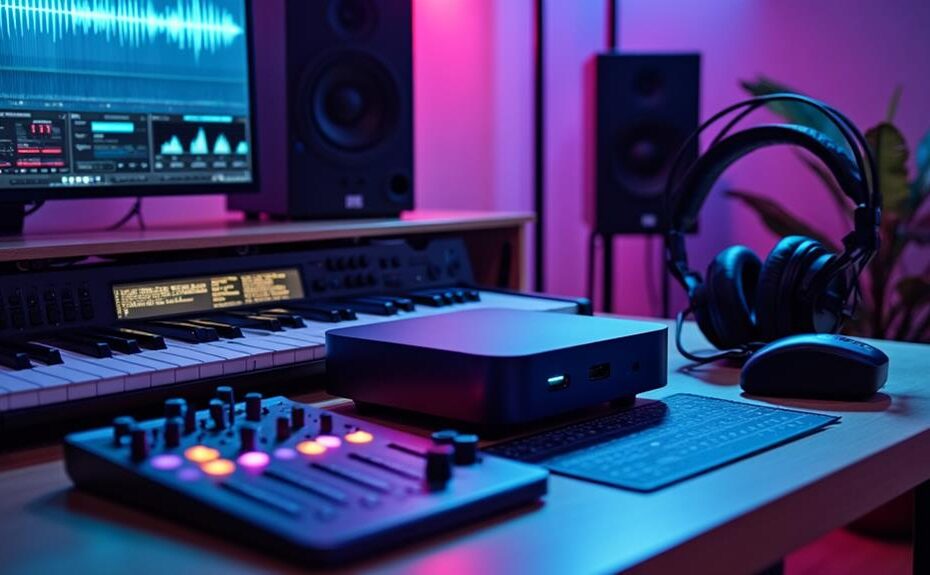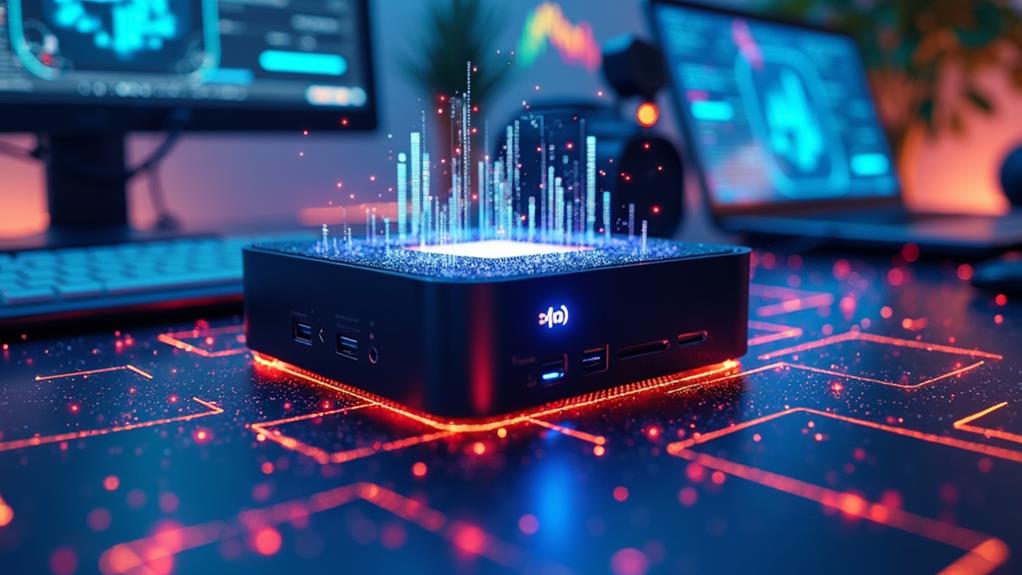



Yes, a Mini PC can handle professional audio engineering tasks if it has the right specifications. You'll need a high-performance multicore processor, ideally an Intel Core i7/i9 or AMD Ryzen, along with at least 16GB of RAM. Solid-state drives guarantee fast data access, and using a quality audio interface is vital for low-latency operations. Optimizing your system by disabling unnecessary processes can further enhance performance. While mini PCs are capable of running Digital Audio Workstations and support various applications, understanding which configurations work best will help you maximize efficiency and output quality. There's much more to explore.
Key Takeaways
- Mini PCs can handle professional audio tasks if equipped with high-performance multicore CPUs and at least 16GB of RAM.
- Solid-state drives (SSDs) are essential for faster data access and improved productivity in audio engineering.
- Quality audio interfaces are crucial for low-latency performance, enhancing audio input/output capabilities in mini PCs.
- Effective thermal management is necessary to prevent overheating during long audio sessions, ensuring stable performance.
- While mini PCs are suitable for many audio tasks, they may struggle with demanding music production due to processing power limitations.
Hardware Considerations
When setting up a mini PC for audio engineering, hardware considerations play an essential role in guaranteeing peak performance. A fast, multicore CPU is fundamental, ideally featuring a minimum of 8 cores with high clock speeds. This guarantees you can handle complex processing demands, especially when working with multiple tracks and effects. For low-latency audio input and output, invest in a quality USB or Thunderbolt audio interface. This component is significant for maintaining high fidelity during recordings and playback. Additionally, efficient cooling systems are imperative for maintaining performance during intensive audio processing tasks, guaranteeing a conducive studio environment.
Moreover, opt for solid state drives (SSDs) for storage. SSDs offer faster read and write speeds, imperative for accessing large sample libraries and VST plugins efficiently. This is particularly important as you'll want to minimize any delays that can disrupt your workflow. Additionally, verify you have sufficient RAM—at least 16GB—to accommodate multiple VST plugins and large audio files. Insufficient RAM can lead to system slowdowns during intensive sessions, hampering your productivity. Finally, effective heat management solutions, such as robust cooling systems, are crucial in a mini PC setup to prevent overheating during long audio processing tasks. Prioritizing these hardware elements will set you up for success in audio engineering.
Latency Reduction Strategies
To achieve ideal performance in audio engineering, employing effective latency reduction strategies is essential. Start by optimizing your operating system, particularly on Windows. Disable unnecessary services and background applications to streamline resources. Utilizing low-latency audio drivers, such as ASIO, is vital for enhancing audio processing performance and minimizing delay during recording and playback. Additionally, using a compact and energy-efficient system, like mini PCs, can help improve overall performance and reduce clutter in your workspace, making it easier to focus on your audio tasks space-saving design.
Another key tactic is to reduce the number of USB devices connected to your mini PC. This helps prevent bandwidth congestion on the USB bus, which can lead to increased latency. If you're looking for even lower latency options, experiment with PCIe sound cards. These often provide superior performance compared to standard USB audio interfaces, making them a great choice for your audio engineering tasks.
Use Cases and Applications
In the domain of audio engineering, mini PCs present a versatile solution tailored for various applications. They excel in live VST hosting and digital mixing, making them invaluable during performances and studio work. Their compact design makes them ideal for content creators looking for efficient streaming and recording solutions. Additionally, mini PCs can run digital audio workstations (DAWs) smoothly, providing high-quality audio output with minimal latency, which is essential for live setups and studio environments. This compact form factor allows for seamless integration with recording equipment, enhancing overall production quality in audio production capabilities.
Mini PCs for music provide impressive processing power, allowing you to offload audio processing from streaming PCs. This enhances overall system performance during live broadcasts, ensuring that your audio remains crisp and clear. Additionally, they can effectively correct latency-related desync issues in OBS, ensuring audio and video stay synchronized during recordings.
While mini PCs offer seamless integration with audio interfaces, they may not be best suited for professional music production. Potential limitations in processing power and software compatibility compared to larger systems can hinder more complex projects. Nevertheless, for tasks such as live performances, mixing, and content creation, mini PCs serve as a compact and efficient option that meets the demands of modern audio engineering workflows. Hence, understanding their use cases can help you leverage their capabilities effectively while recognizing their limitations.
Platform Considerations
Selecting the right platform for your mini PC can greatly impact your audio engineering workflow. If you opt for an M1-based Mac Mini, you can benefit from impressive low latency performance, reaching as low as 3ms. This makes it an excellent choice for real-time audio processing, and with the anticipated M2 Mac Mini, you can expect enhanced efficiency and performance that further bolsters your audio production capabilities.
On the other hand, Windows-based mini PCs can also serve you well, but they necessitate careful optimization to achieve minimal latency levels. This optimization process can be time-consuming and critical for professional audio tasks where every millisecond counts.
Alternatively, you might consider Linux-based mini PCs, which can deliver competitive low-latency capabilities, appealing especially to those who favor open-source solutions. Each platform presents distinct strengths, so your choice should align with your specific audio engineering needs and preferences. Overall, understanding these platform considerations can help you make an informed decision that enhances your productivity and sound quality in the studio or on the go.
Contingency Planning
Regularly preparing for potential hardware failures is vital in audio engineering, as unexpected issues can severely disrupt your workflow. Effective contingency planning involves having spare components or backup systems readily available, minimizing downtime during critical tasks. Consider investing in high-quality cables and power supplies to reduce the risk of signal degradation, which can lead to electrical issues that disrupt audio processing.
In addition, developing a robust backup plan for power loss is important. Utilizing uninterruptible power supplies (UPS) guarantees your work can continue or that projects can be saved during unforeseen outages. This not only protects your current projects but also enhances your overall workflow resilience.
Furthermore, consider implementing redundant systems or failover mechanisms. These allow for seamless shifts between primary and backup equipment, maintaining efficiency even when hardware failures occur. Embracing an "expect the unexpected" mindset prepares you for unforeseen challenges that may arise in professional settings, making sure you remain adaptable and ready to respond.
Performance Considerations
A high-performance mini PC is fundamental for audio engineering, as it directly impacts your ability to manage complex projects efficiently. To achieve peak performance, you need high-performance processors, like Intel Core i7/i9 or AMD Ryzen, which can handle demanding tasks involving multiple tracks and effects. Adequate RAM capacity of 16GB or more is essential, allowing you to run several audio applications and VST plugins simultaneously without experiencing latency issues.
Additionally, utilizing solid-state drives (SSDs) can greatly enhance your productivity through faster boot times and quick access to large audio files, which is crucial in a professional setting. While integrated graphics may suffice for basic tasks, investing in dedicated graphics cards can support GPU-accelerated audio processing, further improving your system's performance during demanding sessions.
Moreover, efficient thermal management is critical to prevent overheating, guaranteeing stable performance during intensive audio processing tasks. By prioritizing these performance considerations, you can make sure your mini PC not only meets but exceeds the requirements of professional audio engineering, enabling seamless multitasking and a smoother workflow overall.
Connectivity Features
Connectivity is a significant aspect of any mini PC designed for audio engineering, as it directly influences your ability to interface with various essential devices. Mini PCs typically come equipped with multiple USB ports, allowing you to connect audio interfaces, MIDI controllers, and other peripherals important for your tasks. Advanced connectivity options like Thunderbolt 3/4 and USB-C ports further enhance your setup, enabling high-speed data transfer and compatibility with a wider range of studio equipment.
In addition to USB connections, many models feature high-speed Ethernet or Wi-Fi capabilities, ensuring reliable data transfer for file sharing, online collaboration, and streaming audio content without interruption. This reliability is fundamental when you're working on intricate audio projects that require real-time collaboration or high-quality streaming.
Moreover, mini PCs often include DisplayPort or HDMI outputs, facilitating seamless integration with external displays and monitors. This is particularly important for visualizing audio editing and mixing processes, as a larger screen enhances your workflow efficiency. Bluetooth and wireless connectivity also allow you to control audio devices and integrate mobile devices into your music production workflow, further expanding your creative possibilities.
Choosing the Right Mini PC
When selecting the right mini PC for audio engineering, consider your performance needs carefully. Prioritize a fast, multicore CPU, like the Intel Core i7, as it's essential for handling the demanding requirements of music production. A robust processor guarantees smooth operation, even when running multiple tracks and plugins.
Opt for at least 16GB of RAM to manage audio sessions effectively without lag. This memory capacity allows you to work seamlessly with complex projects.
Storage is equally important; choose solid-state drives (SSDs) to achieve faster data access speeds. SSDs are fundamental for loading large sample libraries quickly and recording high-quality audio without delays.
Additionally, make sure your mini PC has an extensive range of connectivity options. Multiple USB ports and Thunderbolt support are significant for connecting various audio interfaces and peripherals, enhancing your workflow.
Lastly, consider thermal management solutions to prevent overheating during extended sessions. This consideration will help maintain consistent performance, allowing you to focus on your music without interruptions. By following these guidelines, you'll find a mini PC for music that meets your professional audio engineering needs effectively.
Disclosure: As an Amazon Associate, I earn from qualifying purchases.






